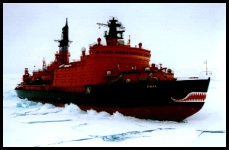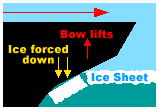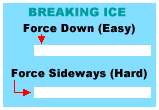
 How Icebreakers Break Ice Icebreakers are designed with sloping bows, heavy construction (lots of weight for their size), and lots and lots of power.
But icebreakers don't try to plow through the pack ice - they use their power and momentum to push the sloping bow up onto the ice. The great weight of the ship then pushes down on the ice, letting gravity do the heavy work.
Ice thickness measured from the top may only be about 2 meters / 6½ feet thick, but thickness measured from the side could be... almost endless! PICTURE: The Russian nuclear powered icebreaker "Yamal".
Click pictures for more information and credits. Library: Arctic, Boats/Ships/Submarines Links: Arctic, Boats & Ships Arctic Maps & Weather Reports |

|
DICTIONARY: Just "double-click" any unlinked word on this page for the definition from Merriam-Webster's Student Electronic Dictionary at Word Central. |

|
ARCTIC LIBRARY & GLOSSARY: Check this section for an index of the rest of the things you really need to know about the Arctic. |

|
ARCTIC MAPS & WEATHER REPORTS: Maps of the Northwest Passage, explorers' routes, iceberg sources, Nunavut, the Arctic by treeline, temperature... |

|
ARCTIC LINKS: Even more information! Links to sites related to the Arctic and "Iceberg: the Story of the Throps and the Squallhoots". |

|
GUIDE TO ARCTIC SUNRISE & SUNSET: How much sunlight or darkness is there in the Arctic on each day of the year? |
to is the property of their respective owners, and Athropolis is not responsible for their content.

